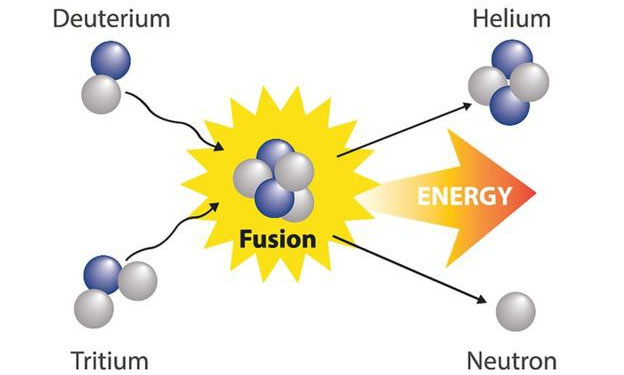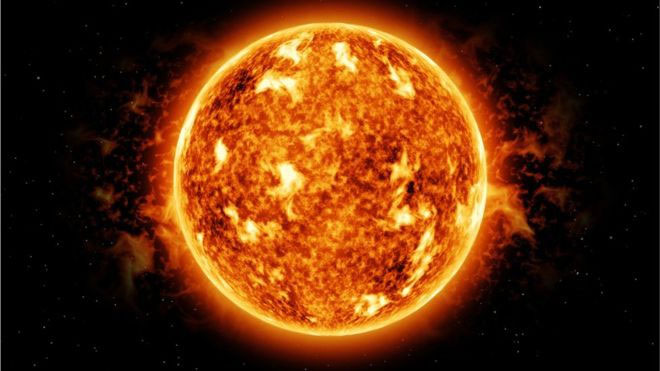Why are China and many countries racing to make artificial sun?
In the search for clean energy, China and many countries are seeking fusion reactor solutions.
Human energy needs never seem to have a limit. From fossil fuels, we begin to learn about nuclear energy, then the forms of renewable energy.
However, any form of energy has its drawbacks. Fossil energy is cheap but polluting, high-cost and low-cost renewable energy, while nuclear energy has a radiation risk. Finding an infinite source of energy is the dream of man.

Illustrate the process of fusion reaction.(Photo: BBC).
In fact, in nature there is an almost infinite source of energy: energy from the sun. The energy of this star comes from the fusion reactor "inside the core." Therefore, using the same theory to create "artificial suns" is the goal of many scientists.
Principle of the energy formation of the Sun
Inside the core of the Sun lies a "nuclear reactor" . Different from the principle of the current nuclear furnaces on Earth that uses fission, a chain of reactions that splits uranium atoms to release energy; the process that takes place in the core of the Sun is a fusion reaction that does the opposite of fusing atoms together.
When two hydrogen nuclei fuse together to become helium, they create a huge source of energy. This process is called fusion or fusion. This reaction generates all of the energy, including the light and heat of the Sun.

The Sun is a giant fusion reactor.(Photo: Getty).
It was previously thought that fusion reactions could only take place in the solar core. That's because the temperature at the core of the Sun is so hot, up to millions of degrees Celsius, that makes atoms exist only in ionized or plasma form. The pressure inside the cores of giant stars makes it possible for nuclei to collide and combine to form a heavier nucleus.
Based on this principle, scientists have sought to create a thermonuclear reaction by providing extreme heat and pressure.
This is also the reaction that produces light and heat of the sun, creating super-clean endless energy for mankind if we find a way to control the thermonuclear reaction. One of the most commonly used designs is the tomatak reactor. Designed by Soviet physicists in the 1950s, this reactor uses a strong magnetic field to pressure, squeeze the plasma inside the reactor.
When the temperature and pressure are large enough, the nuclei inside the plasma are squeezed together to form new nuclei, simultaneously releasing neutrons and energy. This energy heats the surface of the heart, which is the energy obtained.
Ambitious projects
Until now, thermonuclear reactions have not yet been the key to the endless thirst for energy. The reason is simple: to create a certain amount of energy from a fusion reactor, people are having to spend more than that to create the right environment and chemicals.

Circles with a circumference of up to 900m for the ITER fusion reactor project.(Photo: Bloomberg).
To get tritium, one may have to make a side effect after fusion, or extract from water that is rich in deuterium. However, these forms are very expensive.
The Jet Laboratory, where Europe's most powerful tomatak machine uses only deuterium and tritium fuel for the most important tests. In 1997, Jet used 50% deuterium and 50% tritium fuel, achieving an output power of 16 MW compared to energy to heat 24 W. This ratio, also known as Q, reached 0.67. This is a record so far no fusion reactor has yet passed, or in other words no device has "interest" in terms of energy.
China - the world's largest electricity consumer - can't stand out from this game either. They have many thermonuclear projects being implemented at the same time, of which the HL-2M project is nearing the operational stage. HL-2M is located in Leshan City, Sichuan Province, which is the result of research by China National Atomic Company and Southwestern Institute of Physics. The internal temperature of this device can reach 200 million degrees Celsius, which is about 13 times hotter than the core of the Sun.

China's HL-2M fusion reactor will be operational next year.(Photo: Xinhua).
In addition to HL-2M, China has another thermonuclear project in Hefei City, Anhui Province. EAST's state-of-the-art superconducting reactor has reached a temperature of 100 million degrees Celsius.
The largest fusion project being implemented is ITER, the reactor is located in France. This is a great project, with a combination of 35 countries. This reactor has a total budget of 22 billion USD, and is currently about 65% complete. ITER will be operational by 2025.
"This is the first time in human history that nations representing more than half of humanity and 80% of GDP have joined hands to reach a very important common goal ," said Bernard Bigot, CEO of ITER. share.
Over the past 10 years, many advances in materials have helped scientists come closer to achieving the "breakeven" energy level from fusion reactors. The dream to obtain endless energy from fusion is probably no longer impossible.
"I study fusion because I believe it is necessary to change the world. I believe that we will do it," Ian Chapman, director of the UK Atomic Energy Agency, told. Guardian.
- Germany tests "world's largest artificial sun"
- The following year, China's artificial sun came into operation
- Top of the best racing games on iOS
- Why must F1 riders lie while driving?
- How to speed up to win the final meters of the bike race
- China wants to dominate global artificial intelligence
- Artificial rain
- Video: Development history of the racing helmet
- How to make artificial rain in the desert
- Successfully crafted a moving robot hand like a human hand
- Close-up of artificial waterfalls
- The artificial moon of China: forever a dream
- China: Rich countries need to help poor countries improve their climate
- Will supersonic rockets start World War 3?
 The US company is about to build a supersonic passenger plane of 6,000km / h
The US company is about to build a supersonic passenger plane of 6,000km / h Japan develops avatar robot as in fiction film
Japan develops avatar robot as in fiction film Australia tested the world's first mango picking robot
Australia tested the world's first mango picking robot America develops technology to separate water from animal waste
America develops technology to separate water from animal waste